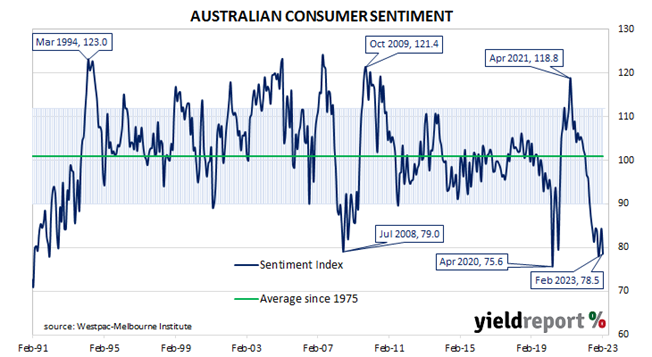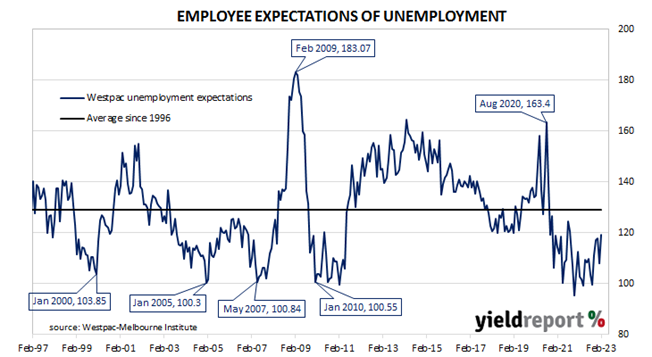Summary: Household sentiment deteriorates in February; cost of living pressures, interest rate rises “weigh heavily”; consumers expect “substantial” rate rises; all sub-indices lower; more respondents expecting higher jobless rate.
After a lengthy divergence between measures of consumer sentiment and business confidence in Australia which began in 2014, confidence readings of the two sectors converged again in mid-July 2018. Both measures then deteriorated gradually in trend terms, with consumer confidence leading the way. Household sentiment fell off a cliff in April 2020 but, after a few months of to-ing and fro-ing, it then staged a full recovery. However, consumer sentiment has deteriorated significantly over the past year, while business sentiment has been more robust.
According to the latest Westpac-Melbourne Institute survey conducted in the second week of February, household sentiment has resumed deteriorating. Their Consumer Sentiment Index fell from January’s reading of 84.3 to 78.5, a reading which is well below the “normal” range and significantly lower than the long-term average reading of just over 101.
“Cost of living pressures and interest rate rises continue to weigh heavily,” said Westpac senior economist Matthew Hassan. “Hopes of some easing in both have been dashed by the strong December quarter CPI and the RBA’s resumption of its interest rate tightening cycle.”
Any reading of the Consumer Sentiment Index below 100 indicates the number of consumers who are pessimistic is greater than the number of consumers who are optimistic.
Commonwealth Government bond yields moved lower on the day. By the close of business, the 3-year ACGB yield had slipped 1bp to 3.47%, the 10-year yield had lost 2bps to 3.75% while the 20-year yield finished 3bps lower at 4.08%.
In the cash futures market, expectations regarding future rate rises over the next few months softened a little. At the end of the day, contracts implied the cash rate would rise from the current rate of 3.32% to average 3.495% in March and then increase to an average of 3.895% in May. August contracts implied a 4.11% average cash while November contracts implied 4.095%.
Hassan noted it was not just the most recent rate rise which had depressed sentiment. “Given that the move was widely anticipated, the negative response likely reflects the clear signal from the RBA Governor that further increases can be expected in the months ahead. Certainly, more consumers now expect substantial follow-on rate rises.”
All five sub-indices registered lower readings, with the “Time to buy a major household item” sub-index posting the largest monthly percentage loss.
The Unemployment Expectations index, formerly a useful guide to RBA rate changes, rose from 108.0 to 119.4. Higher readings result from more respondents expecting a higher unemployment rate in the year ahead.



